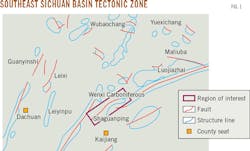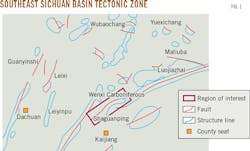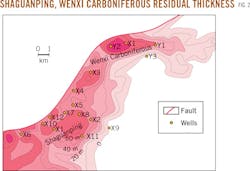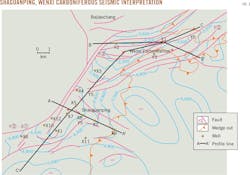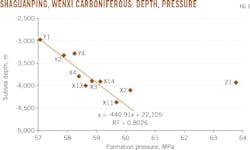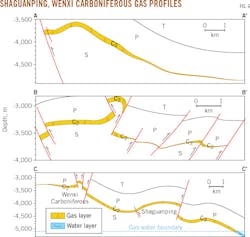New analysis unifies reservoirs in northeastern Sichuan basin
Lei Huang Zongyang Dai
Southwest Petroleum University
Chengdu, China
Zheng Li
Weihe Energy Development Co. Ltd.
Shanxi, China
Ren Luo Lingping Zeng
Petrochina Southwest Oil & Gasfield Co.
Chengdu, China
Recent exploration and development of the Carboniferous system in the northeastern portion of China's Sichuan basin has improved the data available to researchers. Further study is providing solutions to problems of identifying connectivity within the region's gas reservoirs.
Research has identified western Wenquanjing and Shaguanping as adjacent stratigraphic structural gas-bearing combination traps previously to be independent. This article shows that the connectivity between Carboniferous gas pools in western Wenquanjing and Shaguanping is perfect and that they belong to the same stratigraphic-structural combination trap.
History
The Carboniferous gas pool of Shaguanping began production in 1982. Wenquanjing was brought onstream in 2003. They have respective gas bearing areas of 27.43 sq km based on a countour of -4,400 m and 14.03 sq km calculated by a gas-water interface of -3,800 m.
Studies of trap types and characteristics of the pools in western Wenquanjing and Shaguanping have yielded positive results. On the Carboniferous interface structure chart, the Wenxi and Shaguanping tectonic zones are in the west of Wenquanjing's latent anticline zone, and are connected by a saddle. The positional connection between these two gas pools, or its absence, has challenged geologists for years, but most researchers considered them to be independent.
General geology
Wenxi and Shaguanping gas pools are in Kaijiang and Xuanhan Counties, Sichuan Province, China, and belong to the Wenquanjing tectonic zone in a median fold, high-dip region in the southeast Sichuan basin (Fig. 1). Wenxi, in the west of Wenquanjing tectonic zone, is at the junction of Shuangshimiao and the Huaying Mountains in a high-dip tectonic region of eastern Sichuan. The Shaguanping tectonic zone is a nosing structure in the southwest part of Wenxi's faulted anticline.
After the Caledonian and Yunnan crustal movements, the Carboniferous stratum was weathered and eroded in a large area. Only the Middle Carboniferous (Huang formation) remains and appears disconformable in its contact with the overlying Permian. Well data and regional background have revealed that the distribution of the Carboniferous stratum is continuous from Wenxi to Shaguanping, with one denudation pinchout area on its east side.
The formation gradually thins eastward until it finally pinches out. The Carboniferous strata are generally 40-70-m thick, but vary due to a number of faults in the area. In Shaguanping, from Wells X2 to X9, the Carboniferous strata thin in an eastward direction, from 60 m to pinchout. In the main part of Wenxi, the thickness of Carboniferous strata is generally 20-60 m, but the formation is not present in Wells Y3 and Y7.
The overlying Permian Liangshan formation and underlying Silurian argillaceous rocks are in direct contact, which forms denudation pinchout in a lateral shielding trap (Fig. 2). Shaguanping and the west of Wenxi are leaped by a deep fault, which has amplitude of hundreds of meters, creating an efficient shield for migration and accumulation of natural gas. Wenxi and Shaguanping Carboniferous gas pools are formed through stratigraphic-tectonic combination traps.
Structural relationship
The most important features of a gas reservoir are the unified pressure system and gas-water interface. The pressure system is a reservoir integration controlled by the same pressure source and the gas-water interface. Each can influence reservoir fluid to transfer pressure.
Shaguanping Carboniferous gas field has a unified pressure system, and the entire reservoir is connected. Data from well interference testing also show several wells in Wenxi as connected. The connectivity analysis of oil and gas reservoirs usually includes dynamic and static aspects.The research conducted for this article mainly used static data.
Seismic interpretation in 2010 showed Wenxi and Shaguanping to be high points of two adjacent secondary anticline structures in Wenquanjing's latent anticline zone (Fig. 3). The saddle connecting these formations shows a minimum altitude of -3,950 m, lower than the gas-water interface (-3,800m) identified in the Wenxi gas pool and higher than the gas-water interface (-4,400 m) in the Shaguanping gas pool.
There are no grooves, no lithology mutations, and no major fault transverse structures between the two high points, and the reservoirs are continuous. Based on these structural characteristics, a single gas accumulation with a unified gas-water interface is more likely than these formations being two independent gas pools.
Gas-water interface
The Wenxi-Shaguanping Carboniferous gas reservoir is one of few gas pools in China without produced water. A gas reservoir is concentrated in the core of Kaijiang-Liangping palaeohigh. The trap has good characteristics of inheritance from the previous tectonic evolution, allowing it to easily form oil and gas reservoirs with high coefficients of fullness. The Carboniferous well with the lowest bottom elevation serves as the gas-water interface for this analysis.
Well X6, at the southwest of the Shaguanping structure, featured the lowest production elevation, with a bottom of -4,798.72 m. Accordingly, the gas-water interface of the Wenxi-Shaguanping reservoir should be below -4,800 m. In addition, making use of the gas water intersection, the data obtain the gas-water interface elevation of -5,300 m. So the gas-water interface of the unified Wenxi-Shaguanping Carboniferous gas reservoir should be -4,800-5,300 m.
The average of the two methods produces a gas-water interface of -5,050 m (Fig. 6), lower than previously speculated. This interface provides a 180-sq km gas-bearing area in Wenxi-Shaguanping.
Reservoir connectivity
Connectivity is an important parameter for hydrocarbon reservoirs, providing the basis for communication between wells. Carboniferous reservoirs mainly contain arenite dolomite rock and silty-fine breccioid dolomite. Reservoir space is primarily intragranular, intergranular dissolved pores, and moldic pores, with some caves. Longitudinally, the Carboniferous is developed in upper and lower reservoir sections. The thickness of the lower reservoir-a debris-beach facies reservoir-is the largest. This lower section has better properties and is the main production layer of the Carboniferous system.
Taking 2% as the lower limit of effective reservoir porosity yields a single-well log interpretation accumulative thickness of 22-27 m and stable transverse contrast (Fig. 4). The upper reservoir section is developed in the Huanglong formation's third member. The reservoir consists mainly of caves and fissures caused by karst and tectonic movements. Carboniferous reservoirs are primarily fracture and cave-type. Longitudinally, the reservoir is thin, with a short lateral-extended distance.
The Wenxi area features developed faulted structures and strongly folded local strata. The reservoir's fracture extension direction and tectonic axis are basically the same. A large number of fissures associated with fractures help in vertical and horizontal communication. The log interpretation for Wells Y1 and Y4, for example, shows that the reservoir section is fractured, and corresponding core-count seam density can reach 13 m.
Carboniferous supergene karstification created abundant karst caves and fractures, which were beneficial to karst reservoir development. But brecciation weakened deposition's effect in the reservoir. The overlying Permian Liangshan formation mudstone and top of the Carboniferous supergene karst zone also help preserve this natural gas reservoir.
The physical properties of Carboniferous reservoirs in this area have obvious differences among each of the wells. Single-well deliverability tests also differ, but showed strong heterogeneity against the background of overall connection. Some wells need fracturing and acidizing to enhance reservoir connectivity and increase natural gas output.
This Carboniferous reservoir has a close relationship with sedimentary facies, dolomite thickness, and fracture development. For example, Well X3 is between Wenxi and Shaguanping. The Carboniferous strata are 81-m thick, and consist of dense limestone and powder crystal dolostone with a lower proportion of grain dolostones. Weak tectonic movement also means an absence of major faults. Yield, however, can be low even after fracturing and acidizing. The Carboniferous strata of Well X15 is only 2.5 m thick and tests with a light amount of gas, proving that there is no direct relationship between the reservoir's effective thickness and its full thickness.
Pressure analysis
Original pressure coefficient is the ratio of original formation pressure and hydrostatic pressure and is an important component of pressure analysis. A normal pressure coefficient is 0.8-1.2. Coefficients higher than 1.2 are considered abnormally high and those below 0.8 abnormally low. Well Y1 in the Wenxi gas pool has a pressure coefficient of 1.44, similar to the 1.4 found in gas wells in Shaguanping. Both of these fields connect to an abnormally high-pressure gas pool.
This study recorded the original formation pressure of several Carboniferous gas wells in Wenxi, Shaguanping, and Bajiaochang to analyze reduced pressures (Table 1). We first converted the measured depth into vertical depth, and then into altitude (bushing elevation-vertical depth). We then unified the conversions with pay formation pressures to -3,500 m above sea level with a gas pressure gradient of 0.225 MPa/100 m. The pressure distribution in Wenxi and Shaguanping gas pools is 57-59 MPa. The formation pressure and subsea depth in Wenxi and Shaguanping are linear-dependent (Fig. 5) and differ from adjacent Well Z1, which has a pressure of 62.832 MPa.
Gas component
The acid content of natural gas can also be used as a basis for judging connectivity, especially when formation pressure is insufficient to provide evidence. Analysis of the CO2 content in more than 30 wells in both fields showed a 0.8-1.46% concentration in Wenxi and 0.38-1.85% in Shaguanping, demonstrating similarity between the two regions.
Analyses of static and dynamic factors confirm that Carboniferous gas traps in Wenxi and Shaguanping are interrelated and have reservoir connectivity. Pressure coefficients, reduced pressures, and CO2 content are also similar in the two areas, suggesting that the two Carboniferous reservoirs are connected with the same pressure system and same gas-water interface.
The Wenxi-Shaguanping collective reservoir has an overflow point between Tanmuchang and Shaguanping. The trap's main peak is in the western high point of Wenxi, with the top at -2,820 m. The subset high point is the fault nose structure of Shaguanping with the top at -3,620 m (Fig. 6). The lowest entrapped line is below -5,100 m, and the closure exceeds 2,300 m. According to these parameters, the hydrocarbon bearing area of the trap exceeds 200 sq km.
Analysis of the tectonic history and Carboniferous hydrocarbon accumulation data in eastern Sichuan basin confirms that the gas-filling coefficient of the high point in Wenxi and other high points is 100%.
Further analysis
The analysis of Wenxi-Shaguanping gas reservoirs further deepens the geological knowledge of Carboniferous gas reservoirs. It also provides the geological basis for development of the gas reservoir, improves the likely success rate of development wells, and lays the foundation for the reasonable and efficient development of its gas resources.
With the exception of the Cambrian Longwangmiao formation discovery in the Moxi region of Anyue gas field, Wenxi-Shaguanping is a promising single bulk-gas reservoir of marine carbonate rocks and hydrocarbon exploration in the Sichuan uplift has more potential. Similarly, Carboniferous gas reservoirs in the Wenxi-Shaguanping and Kaijiang-Liangping paleohigh regions have not produced water to date, showing promise for further exploration.
Bibliography
Chen, Z., "Forecast, Classification and Assessment for Gas Reservoirs of Carboniferous Stratigraphic-Structural Combination Traps in Eastern Sichuan," Acta Petrolei Sinica, Vol. 21, No. 3, May-June 2000, pp. 25-30.
Committee of Gas and Oil Field Development Standards, "Methodology for the Initial Pressure and the Hydrodynamic System Hydrocarbon Reservoirs," Beijing: Petroleum Industry Press, 1999.
Kang, B., Zhang, F., and Zhang, J., "Control Factors of Carboniferous Stratum-structure Composite Traps in the East of Sichuan," Journal of Oil and Gas Technology, Vol. 30, No. 1, 2008, pp. 184-187.
Li, A., Yi, H., Tu, J., and Wang, F., "Determining the Gas Water Interface of Carboniferous Gas Reservoir in ZG Field by Pressure In Tersection Method," Natural Gas Industry, Vol. 25, supplementary issue A, 2005, pp. 35-37.
Li, J., Xu, G., and Yan, W., "Identification and Prediction of Fractures in Carboniferous Reservoirs of Shaguanping Gas Field, East Sichuan Basin," Natural Gas Industry, Vol. 28, No. 11, 2008, pp. 49-52.
Margot, G.G., Louis, J., and Durlofsky, L., "Modeling Fluid Flow in Oil Reservoirs," Annual Review of Fluid Mechanics, Vol. 37, 2005, pp. 211-238.
Ran, H., "Gas Water Distribution Characteristics of Carboniferous Gas Reservoirs in East Sichuan and a discussion on Their Geneses," Natural Gas Industry, Vol. 21, No. 1, 2001, pp. 52-56.
Wang, Y., Chen, S., and Xu, S., "Formation Conditions and Exploration Technique of Gas Reservoir for Paleozoic Erathem-Upper Proterozoic Suberathem in Sichuan basin," Beijing: Petroleum Industry Press, 2001, pp. 118-145.
Xiao, S., Xia, M., and Wang, D., "Evaluation and Research on Accumulation Features of Carboniferous Reservoirs in Linbei Structure of East Sichuan," Petroleum & Oilfield Development in DaQing, Vol. 24, No. 4, 2005, pp. 28-30.
Xu, G., Wang, D., Wang, Q., Zhou, L., and Zhang, R., "Sedimentary Microfacies Feature and the Reservoir Permeability Units in Carboniferous, Shaguanping, Eastern Sichuan," Journal of Southwest Petroleum University (Science & Technology Edition), Vol. 32, No. 2, 2010, pp. 170-174.
Yu, H., He, S., and Zhang, H. "Analysis of Formation Factors of Carboniferous in West Wenquanjing Field of Northeast Sichuan and Its Exploration Prospect," Science Technology and Engineering, Vol. 7, No. 17, 2007, pp. 4454-4458.
The authors
Lei Huang ([email protected]) is a PhD candidate in geological resources and geological engineering at the School of Geoscience and Technology, Southwest Petroleum University, Chengdu, China. She holds a BSc and an MSc in mineral prospecting and exploration from Southwest Petroleum University.
Zongyang Dai ([email protected]) is an associate professor in the School of Geoscience and Technology, Southwest Petroleum University. He holds a BSc and an MSc in geological resources and geological engineering from Southwest Petroleum University.
Zheng Li ([email protected]) is an engineer in Shanxi Gas Group Weihe Energy Development Co. Ltd. He holds a BSc and an MSc (2012) in mineral prospecting and exploration from Southwest Petroleum University.
Ren Luo ([email protected]) is an engineer at Petrochina Southwest Oil & Gasfield Co. He holds an MSc in mineralogy, petrology, and mineral deposit geology from Southwest Petroleum University.
Lingping Zeng([email protected]) is an engineer at Petrochina Southwest Oil & Gasfield Co. He holds a BSc in resource reconnaissance engineering from Chengdu University of Technology.
